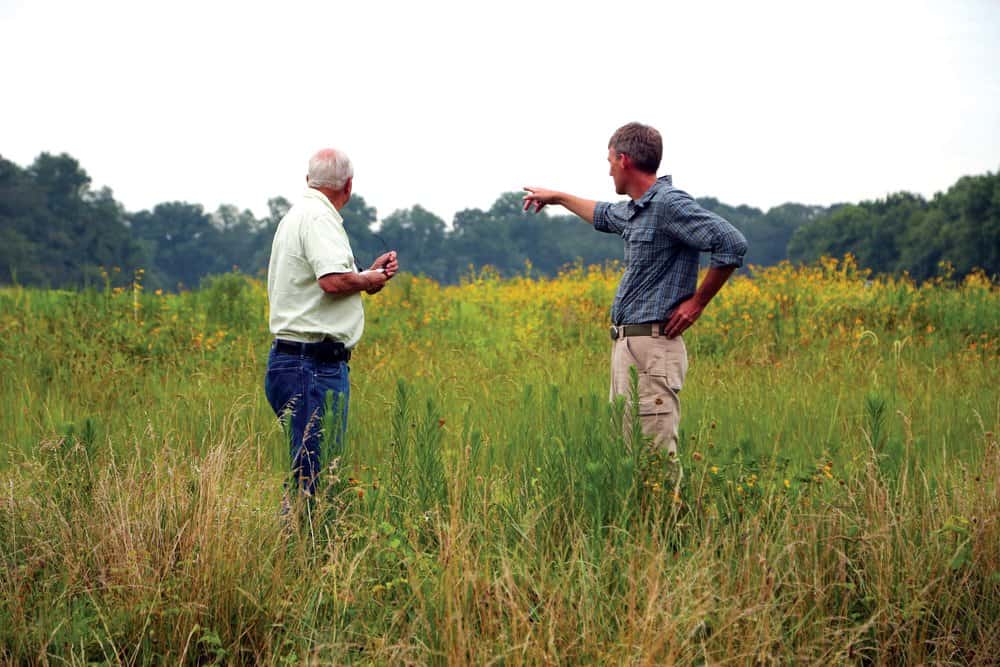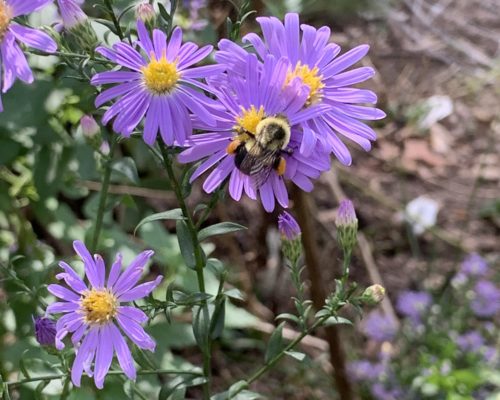Just south of Chestertown, a bumpy country road winds through centuries-old farm fields. A soft June breeze filters a kaleidoscope of sunlight through the trees onto the uneven macadam. Ahead, Dan Small’s little orange pickup sits like a channel buoy, marking a gap in the hedgerow, the entrance to a portion of The Washington College River and Field Campus and home of the Chester River Field Research Station (CRFRS).
Tall and slim with a quiet manner, Small, the Natural Lands Project (NLP) coordinator for Washington College’s Center for Environment and Society, also manages the field station, 228 acres along the Chester River. Today he’s leading a covey of us—a farmer and a few gardeners, birders and naturalists—through the station’s meadows, which are essentially a boots-on-the-ground laboratory for wildlife restoration.
“We do both conservation and behavioral studies here,” says Small, whose work is buttressed by the bird-banding and research done at 20-year-old Foreman’s Branch Bird Observatory, also on The River and Field Campus. ¶ In some ways, this facility is about providing habitat for the beautiful, northern bobwhite quail, whose distinctive bob-WHITE! call, simultaneously plaintive and hopeful, once echoed all around the Chesapeake. But by the time Small began working to replenish the quail here, the national population had declined by 80 percent, and the birds were all but gone from this area due to habitat destruction. ¶ “Quail are ground-nesting birds,” Small explains. “The young need to be able to get out of the nest and forage safely.”
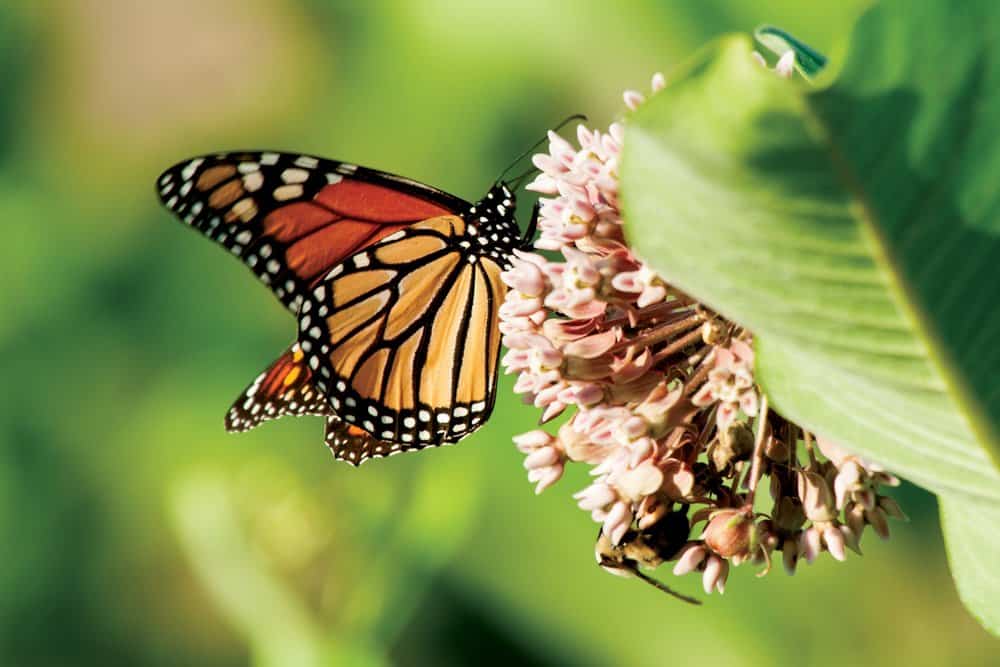
A combination of development and edge-to-edge farming, which leaves no corner of the land untilled, destroys those pockets of habitat and forage that quail have always depended on, turning the landscape into what amounts to a food desert, with all the cover of a parking lot. Unlike migrating birds, which search out their forage and shelter en route (an increasingly challenging task), quail tend to stay in one locale for life and need a reliable mixture of upland native grasses and other native plants. These plants sustain the insects they eat and create an overhead canopy that helps to protect the birds from predators yet leaves the ground below sufficiently open for nesting and forage.
While CRFRS focuses in large part on the quail, NLP has a broader agenda.
“The Natural Lands Project is about water quality,” says Small. In addition to his work here, Small consults with landowners on 25 other properties in Kent, Queen Anne’s and Talbot counties. “Part of the NLP funding pays for the seed mix and the labor to get a space planted,” he says. “We also offer an incentive payment to the landowner to put in habitat and work with CRP [Conservation Reserve Program] and CREP [Conservation Reserve Enhancement Program] for the landowner’s 10-year maintenance agreement.”
Creating planted riparian buffers 100-feet wide not only encourages wildlife but prevents runoff. Additionally, reclaiming less productive portions of farmland for habitat and buffer cuts down on the total amount of fertilizer and herbicides used on the landscape. “And providing native plants attracts pollinators, which is good for crop yield,” Small adds. Without sufficient numbers of pollinators, farmers would be forced to hand-pollinate orchard fruits particularly, as the Chinese must do.
Partners in NLP are Chester River Association (now part of ShoreRivers.org), Maryland’s Department of Natural Resources Chesapeake and Atlantic Coastal Bays Trust Fund, Tall Timbers Research Station and Land Conservancy, Ducks Unlimited, Pickering Creek Audubon, and the National Fish and Wildlife Fund, a coalition that reflects the intimate connection between wildlife habitat and water quality.
“Wildlife is the visible sign of water quality,” says Small.
Science-based, best-land-management practices have been shown to improve water quality, but the gains are often not apparent to the casual observer.
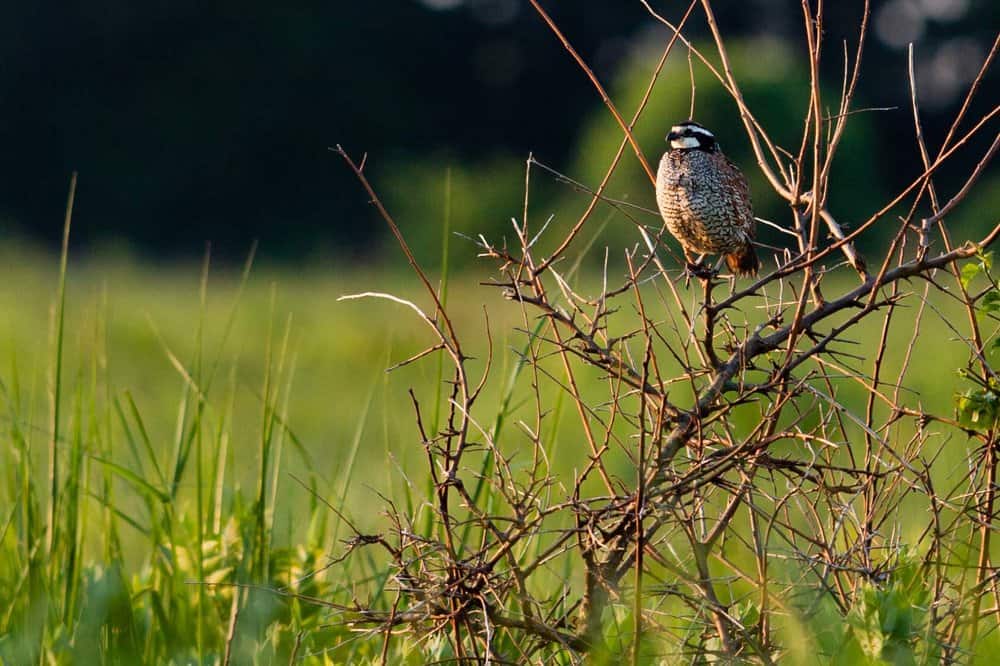
“A farmer can do a lot of things to improve the land, but then visually you never see or feel the benefits from those water quality improvements,” Small says. “But using quail as a motivator, or waterfowl if they’re a waterfowl hunter, they can see the benefit of what they’ve done first-hand rather than a riverkeeper saying, ‘were seeing gains.’”
Rising numbers of game birds such as quail and waterfowl are not simply proof that the environment is improving. These animals are also both larder and livelihood to farmers, a reason in itself to restore their habitat, something that Chino’s owner, Harry Sears, has always known.
“[Chino] was bought for a bunch of New York businessmen to enjoy the outdoor life—shooting, hunting, fishing,” says Sears, whose father was part of a group that bought the farm in the early 1940’s. “It was always a working farm, but also very much a place where these gentlemen had recreational things, and that led to protecting the environment and that which made the recreation possible.”
Which is where quail come in. These lovely little game birds evoke an emotional response that helps motivate change.
“Field sparrows and obscure insects aren’t as sexy,” Small says with a wry smile. “It’s kind of like ‘find that thing that turns people on,’ but the ultimate goal is to improve the water quality.”
But why quail specifically?
“It’s an umbrella species,” he explains. “What quail need will benefit a whole host of other species.”
We walk down mown lanes between meadows of powder-blue big bluestem switch grass and other upland native grasses, our boots splashed with morning dew. Native aster and goldenrod, both late summer bloomers, wave green fronds. Here and there, a black-eyed Susan or a purple coneflower stands like a punctuation mark in the greenery. The broad leaves of a common milkweed, a monarch butterfly host plant, poke through clumps of shrubby sumac. In the distance, two male cardinals call and counter-call to each other, negotiating boundaries. A bluebird, his colors almost electric, darts past.
Clearly if you build it, they will come. In the spring of 2016, the team planted the meadows. In 2017, birds showed up. The nomadic, sparrowlike dickcissel has Small particularly excited.
“In 2017, I went up to do bird surveys and found three male dickcissels and one female on the property,” he says. Dickcissel is a grassland obligate bird, meaning, it only exists in one type of environment. “They come up from South America and move around until they find the habitat. There’s no way those birds would have been here if it was still a crop field. It was really cool to see them find the habitat so fast. And other birds have found it—grasshopper sparrows, field sparrows…”
This year, the 100th anniversary of the Migratory Bird Treaty Act, has been declared the Year of the Bird, an effort to highlight the amazing lives birds lead and to recognize our connection to them and the importance of habitat restoration.
While CRFRS is a build-it-and-they-will-come project, it’s not a plant-it-and-walk-away operation. Keeping out those plants and trees that can quickly change the character of the landscape requires maintenance.
“We do strategic burns and discing and the occasional bush-hog,” says Small. “If sweet gums are close, they’ll come in.”
So would invasive white mulberry, tree of heaven, Bradford pear and other opportunistic thugs. For noxious weeds, a state-specific designation for such things as Canada thistle, they use spot applications of herbicide.
“We’re required to control noxious weeds, but pesticides and fertilizer will never be used on that ground,” says Small. “That’s how we can help improve the Bay—that and preventing runoff. What we do oftentimes is around the periphery of the farm fields or corners too small for equipment. We use the marginal ground for the programs, which makes good habitat and good business sense.”
Water studies show that these efforts pay off in improved water quality too, but there is always something new to learn. Recent studies have shown that pollution also comes from lag-water, which carries pesticides, nitrogen, phosphorous, and other polutants which were used on the land years ago.
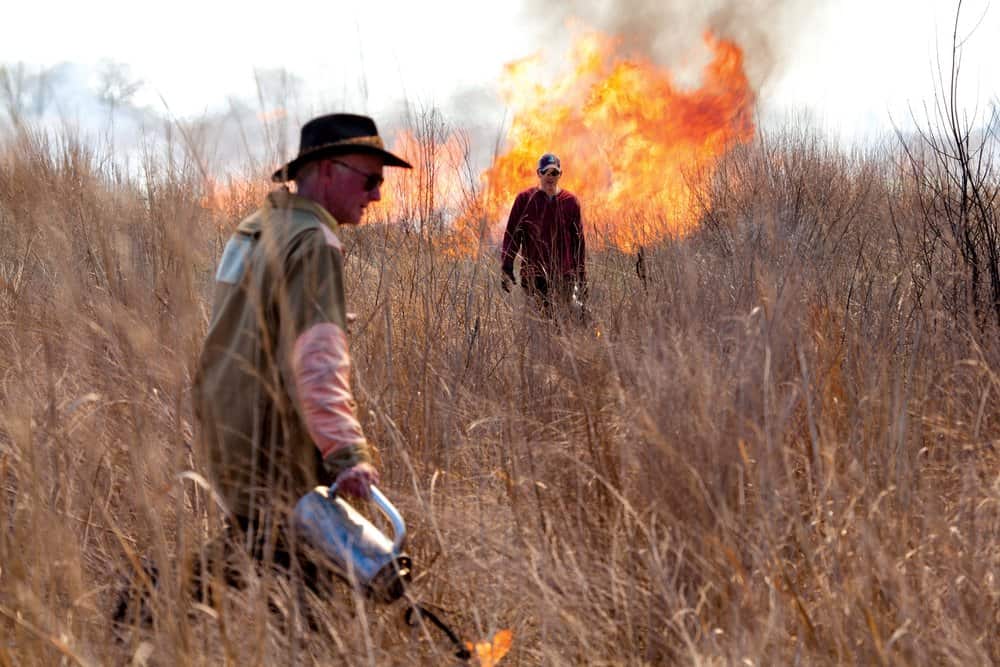
“All that lag-time groundwater that had pollutants in it from practices of 30 to 40 years ago is still making its way through our system,” explains Isabel Hardesty, former Chester Riverkeeper now Regional Director for ShoreRivers. “The good news is that the USGS has been doing groundwater well studies and they’re showing that the younger water, say ten years old, is a lot cleaner than the water that is 30 years old. We are making positive changes, and it’s making a positive impact.”
But the impact, while measurable, is incremental, which is one reason seeing the wildlife increase so quickly is important. The magic of renewed birdsong, rocketing hummingbirds, indigo buntings, orioles and so much more is the semi-instant gratification that keeps us short-attention-span humans moving forward, which helps to feed the long-long-term objective.
“The goal is to reach ecosystem threshold,” says Hardesty. “That’s when the whole ecosystem tips into a positive place where it will be better able to restore itself after events like Conowingo Dam. But getting to that point is not a sprint—It’s a marathon.”
Meanwhile, Small has walked us through long avenues smelling sweetly of grass and wildflowers and looped us back to his orange truck. A bluebird lands on a post at the entry only a few feet from our group and eyes us curiously. After a few moments, he takes off again, heading back into the smorgasbord of insects and seeds now available on CRFRS, a reminder to Small to rebuild some of the bluebird boxes he has dotted around the acreage. It’s all deceptively low-key, but a vital piece of our effort to restore some of the bounty the land and water have always offered. While this land is no longer farmed, it is still incredibly productive, which hugely gratifies Harry Sears.
“This is the best possible use for the farm,” he says.

